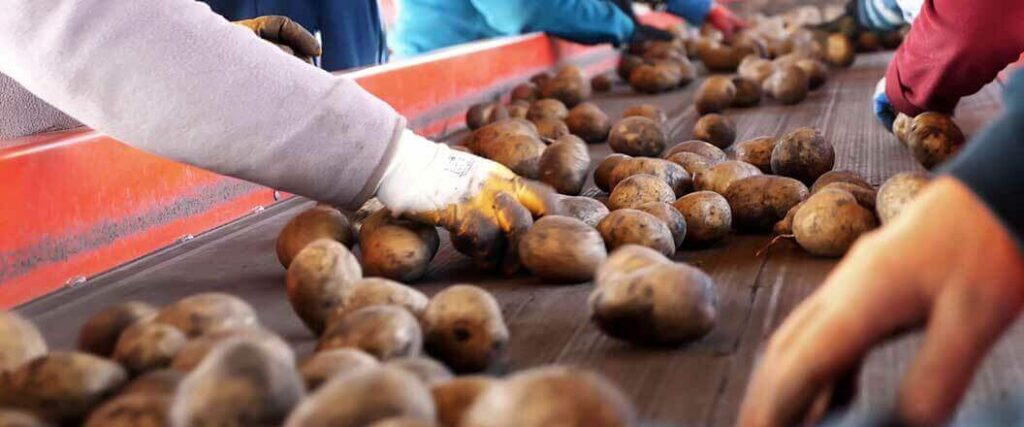How are potatoes transported? Like any good produce, potatoes have specific shipping requirements. Temperature and humidity must be kept at certain levels during transit. This prevents spoiling and keeps the potatoes fresh and delicious when they arrive at their destination. You might find this process surprisingly difficult without the correct equipment.
The International Institute of Refrigeration states that transporting bulk potatoes requires precise temperature control, usually between 3°C to 10°C. Refrigerated trucks are used to manage temperature and humidity in transit. This is essential to keep the potatoes fresh and delicious upon arrival at market.
Are you looking for information about transporting spuds? If so, join us as we review the conditions necessary to move bulk shipments of potatoes from farm to market and beyond.

Potatoes go through a thorough preparation process before they ever reach a truck. This is done to ensure the spuds reach their destination ready fresh and ready to be boiled, mashed, or stuck in a stew.
The process for preparing potatoes for transport usually looks like this:
The conditions under which curing and transportation should take place vary based on factors we’ll discuss further on in the article.

You might still be wondering if the hardy, humble potato even requires refrigerated shipping in the first place. The short answer? Yes, but not always. Let's dig a bit deeper into this question.
The need for a refrigerated truck depends on several factors, including:
If you're just hauling a few bushels to a nearby destination where they'll be used within a matter of days, refrigerated transport might not be necessary. However, potatoes are shipped via reefer truck when a long haul and/or long-term storage are required. Reefer trucks have adjustable temperature controls and ventilation. These features work together to keep humidity at required levels.
Before we dig into shipping temperatures, it's essential to understand the differences between seed, table, and processing potatoes.

Not all potatoes are created equal. Depending on certain qualities (or lack thereof), these tubers are classified as either table, seed, or processing potatoes.
Let's break down these categories:
Selected for their genetic qualities and used for planting new potato crops, their purpose is to ensure a healthy, disease-resistant yield for the next season.
These are the potatoes you find in your local supermarket or grocery store, intended for direct consumption. They come in many varieties such as russet, red, and Yukon gold.
Spuds that aren’t aesthetically pleasing are usually processed into potato chips, french fries, and frozen potato products like hash browns and tater tots.
Each type of potato calls for slightly different shipping conditions.
Armed with this information, we can look at the different shipping requirements for each type of tater.

In the table below, you’ll find the optimum temperatures and humidity ranges for curing potatoes and transporting them via reefer truck.
| Process | Optimum Temperature (°F) | Optimum Temperature (°C) | Humidity Range |
| Curing | 55°F - 70°F | 13°C - 21°C | 85% - 95% |
| Table Potato Transportation | 45°F | 7°C | 90% - 95% |
| Seed Potato Transportation | 39°F | 4°C | 90% - 95% |
| Processing Potato Transportation | 50°F | 10°C | 90% - 95% |
If potatoes aren't properly refrigerated and aerated during shipment, they're at risk of developing the following conditions:
It’s also important to keep sunlight exposure to a minimum. Otherwise, your potatoes may turn green from chlorophyll production. This indicates the presence of harmful chemicals that shouldn’t be ingested.
No one wants to eat squishy, rotten potatoes that taste bitter. To ensure your fresh potatoes don’t get refused by the buyer, it’s a great idea to partner with proven experts in cold chain logistics.
The American appetite for potatoes is insatiable, and all produce shippers can benefit from working with carriers who know how to ship potatoes in large quantities across the country. That’s where we come in.
At USA Refrigerated Freight, you’ll find experts with the vehicles and equipment necessary for effective road transport of potatoes. Trust us with all of your temperature-sensitive shipments, including:
Call our cold-chain experts at (866) 849-4923 or get a risk-free quote today. We’ll make sure your shipment of taters is handled with care.
USA Refrigerated Freight
315 NE 14th Street #4122
Ocala, FL 34470
Question Is it possible to transport 50lbs bags of potatoes on a flatbed truck if the out side temp is 80 degrees or lower over two or three days even 5lbs to 10lbs bags & still deliver fresh goods?????? even covering by tarp????